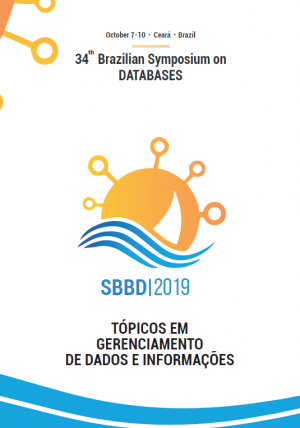Tópicos em Gerenciamento de Dados e Informações: Minicursos do SBBD 2019
Palavras-chave:
Banco de DadosSinopse
Os minicursos apresentados no XXXIV Simpósio Brasileiro de Banco de Dados (SBBD 2019) têm por objetivo apresentar temas relevantes da área de Banco de Dados e promover discussões sobre os fundamentos, tendências e desafios relacionados ao tema abordado, sendo uma excelente oportunidade de atualização para acadêmicos e profissionais que participam do evento.
Nesta edição, foram selecionadas quatro das oito propostas recebidas, para serem apresentadas durante o SBBD 2019. A seleção das propostas foi realizada por um Comitê de Avaliação formado por quatro avaliadores. Durante o processo de seleção, as propostas submetidas foram avaliadas por todos os membros do comitê. Ao final do processo, os proponentes dos minicursos selecionados prepararam os textos que constituem os capítulos deste livro.
O primeiro minicurso, “Técnicas de Privacidade de Dados de Localização”, tem por objetivo apresentar os principais conceitos relacionados ao problema da violação de privacidade de dados de localização dos indivíduos, os riscos inerentes e apontar de forma detalhada as principais técnicas existentes na literatura para a preservação de privacidade em serviços de localização. No segundo minicurso, “Uma Introdução ao Combate Automático às Fake News em Redes Sociais Virtuais”, é apresentada uma introdução conceitual e prática às principais abordagens computacionais de combate às Fake News, além de comentar sobre áreas e pesquisas recentes relacionadas a este tema. Já o terceiro minicurso, “Ecossistemas de Dados na Web: da teoria aos desafios”, discute os principais conceitos relacionados a este novo ambiente, abordando aspectos relevantes, tanto do ponto de vista teórico quanto de desafios e oportunidades de pesquisa nesta área. Por fim, o quarto minicurso, “Aprendizado de máquina e inferência em Grafos de Conhecimento”, apresenta uma introdução aos métodos e técnicas de aprendizado de máquina utilizadas em tarefas de inferência em grafos de conhecimento, discutindo-se os desafios e oportunidades tecnológicas e científicas desse tipo de tarefa.
Capítulos
-
1. Técnicas de Privacidade de Dados de Localização
-
2. Uma Introdução ao Combate Automático às Fake News em Redes Sociais Virtuais
-
3. Ecossistemas de Dados na Web: da teoria aos desafios
-
4. Aprendizado de máquina e inferência em Grafos de Conhecimento
Downloads



